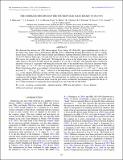THE COMPLETE SPECTRUM OF THE NEUTRON STAR X-RAY BINARY 4U 0614+091
Author(s)
Migliari, S.; Tomsick, J. A.; Miller-Jones, J. C. A.; Heinz, Sebastian; Hynes, R. I.; Fender, R. P.; Gallo, Elena; Jonker, P. G.; Maccarone, T. J.; ... Show more Show less
DownloadMigliari-2010-THE COMPLETE SPECTRU.pdf (439.6Kb)
PUBLISHER_POLICY
Publisher Policy
Article is made available in accordance with the publisher's policy and may be subject to US copyright law. Please refer to the publisher's site for terms of use.
Terms of use
Metadata
Show full item recordAbstract
We observed the neutron star (NS) ultra-compact X-ray binary 4U 0614+091 quasi-simultaneously in the radio band (Very Large Array), mid-infrared (IR)/IR (Spitzer/Multiband Imaging Photometer for Spitzer and Infrared Array Camera), near-IR/optical (Small and Moderate Aperture Research Telescope System), optical-UV (Swift/UV-Optical Telescope), soft and hard X-rays (Swift/X-ray Telescope and Rossi-X-ray Timing Explorer). The source was steadily in its "hard state." We detected the source in the whole range, for the first time in the radio band at 4.86 and 8.46 GHz and in the mid-IR at 24 μm, up to 100 keV. The optically thick synchrotron spectrum of the jet is consistent with being flat from the radio to the mid-IR band. The flat jet spectrum breaks in the range ~(1-4) × 10[superscript 13] Hz to an optically thin power-law synchrotron spectrum with spectral index ~–0.5. These observations allow us to estimate a lower limit on the jet radiative power of ~3 × 10[superscript 32] erg s[superscript –1] and a total jet power L [subscript J] ~ 10[superscript 34]μ[superscript –1] [subscript 0.05] E [superscript 0.53] c erg s[superscript –1] (where E [subscript c] is the high-energy cutoff of the synchrotron spectrum in eV and μ[subscript 0.05] is the radiative efficiency in units of 0.05). The contemporaneous detection of the optically thin part of the compact jet and the X-ray tail above 30 keV allows us to assess the contribution of the jet to the hard X-ray tail by synchrotron self-Compton (SSC) processes. We conclude that, for realistic jet size, boosting, viewing angle, and energy partition, the SSC emission alone, from the post-shock, accelerated, non-thermal population in the jet, is not a viable mechanism to explain the observed hard X-ray tail of the NS 4U 0614+091.
Date issued
2010-02Department
MIT Kavli Institute for Astrophysics and Space ResearchJournal
Astrophysical Journal
Publisher
Institute of Physics/American Astronomical Society
Citation
Migliari, S., J. A. Tomsick, J. C. A. Miller-Jones, S. Heinz, R. I. Hynes, R. P. Fender, E. Gallo, P. G. Jonker, and T. J. Maccarone. “THE COMPLETE SPECTRUM OF THE NEUTRON STAR X-RAY BINARY 4U 0614+091.” The Astrophysical Journal 710, no. 1 (January 15, 2010): 117–124. © 2010 American Astronomical Society.
Version: Final published version
ISSN
0004-637X
1538-4357